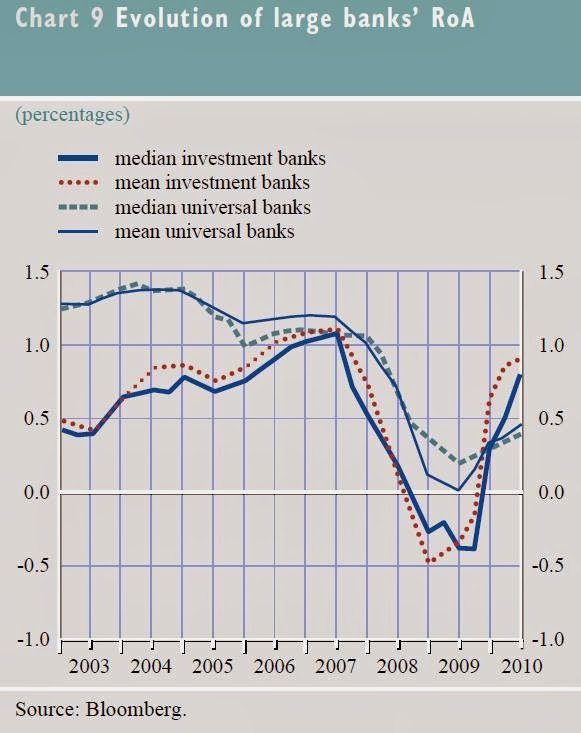The RoE (Return on Equity), an
internal performance measure of shareholder value was a wrong financial
performance measure. Since RoE is the most well-known performance indicator
widely used by market participants and banks themselves in their disclosures
(i.e. at the top line of bank reports), targeting RoE has exposed banks to
higher unexpected risk levels and opened the door to a more shortterm- oriented
approach to balance sheet management. This ratio was not adjusted
for the risks that financial institutions are taking, i.e. leverage funding and
liquidity profile.
Policies, including Basel I, have
encouraged regulatory arbitrage. Reduced capital ratio minimums incentivized
banks to increase leverage and a significant reduction in reserve requirements
in the 1990s, precipitated lower liquidity and higher leverage. This created
the conditions for a financial crisis we are facing today.
In the years 2002–06 before the crisis, profits were high but several large banks required bailouts. Banks increased profits through both balance sheet and off-balance-sheet growth and by taking on riskier asset/liability mismatches.
1. Return on Equity (RoE):
Return on Equity is the primary
measure banks have pursued to evaluate their performance. RoE used to be very
convenient for bankers. The bank board was given a target RoE which they could
achieve in one or two ways: they could increase the returns or hold the equity
low in the RoE measures. In the banking business they did both at the same time,
high returns and equity low.In the years 2002–06 before the crisis, profits were high but several large banks required bailouts. Banks increased profits through both balance sheet and off-balance-sheet growth and by taking on riskier asset/liability mismatches.
1. Return on Equity (RoE):
RoE = net income / average total
equity
Since mid-90’s the banking sector
was underperforming the utility sector and was not serving the investors very
well. It has bankers let to keep equity to a minimum and made them vulnerable
as enterprises and has made the whole financial system very fragile.
What are proper ways to value the
banks? What are the measures bank management and investors should be focusing
on?
If bankers continue to pursue the
target RoE they should wait for a longer period of years of time to measure if
they have hit the target or not and to reward themselves. If they don’t wait this
period for the consequences of the risks taking with the equity they are given. Than they need to adopt intra measures that are risk adjusted.
2. Return on Assets (RoA):
Return on Assets (RoA)
is a basic measure of bank profitability that corrects for the size of the bank.
RoA = net income / average total assets
RoA = net income / average total assets
3. Return on Risk-Weighted Assets (RoRWA):
By introducing the measure Return
on Risk-Weighted Assets (RoRWA) the boards and executive management needs to
focus on the issue of risks. What risks are banks taking, what order of magnitude,
what are the potential outcomes, in which area. These risk weights come out of Basel
regulations, exposure against which they are measured are generated by the
banks themselves. Since the crisis there are new Basel regulations, Basel III
which is an improved version of Basel II/2.5. Now also capital and liquidity
requirements, including the Tier I capital leverage ratio, liquidity coverage
ratio, and the net stable funding ratio are primary measures of a bank.
But are these Basel-driven risk
weightings right? Does a bank board need to judge these weightings themselves? Which
other measures do we need to take into account to let banks better perform than
in the past? The RoE was the primary measure of many banks which they pursued
in terms of the profitability objective, the capacity to generate sustainable
profitability. We have seen that it has not contributed to long-term
shareholder value. Instead it has contributed to volatility of returns, excessive
leverage, risk-taking which has made our financial system very unstable. This
has encouraged the banks to keep the equity small as possible and the leverage
as large as possible and has made the financial system fragile. Today, it is very
important to promote financial stability. We have to create well regulated
banks that are more prudent. It means more equity in the mix and having the
right targets to encourage them.
We are investigating how the RoE
changed before, during and after the crisis. What are the main drivers
explaining the RoE changes over the crisis? What are appropriate performance
measures after the financial crisis? Are the Basel regulations good policies or
do need banks themselves consider other measures. Are stress testing programs imposed
by Basel a good tool to supplement other risk management approaches and
measures?


No comments:
Post a Comment